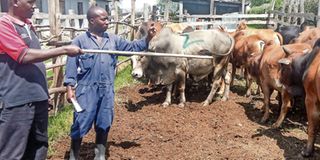Vet on call: What you need to know on setting up a viable beef farm

George Wainaina selects a bull for slaughter in a farm in Machakos County in this past photo. If you wish to go into beef production, you must take time to carefully investigate the intricacies of beef farming and sale of the animals. PHOTO | FILE | NATION MEDIA GROUP
What you need to know:
- I am motivated to write this article by some of the inquiries I have recently received regarding beef farming.
- Betty’s beef buyers recently told her she needed to show that her animals were identified and their origin could be traced for her to continue supplying meat.
- Sue and Kioko could do beef farming since they have sufficient family land to keep some animals and do beef fattening at the same time.
- The best would be to buy animals in low body condition or bulls close to mature weight and fatten them in three to four months.
The Covid-19 pandemic has caused lots of disruptions in many people’s lives locally and globally.
The stark reality has hit home that one can have a comfortable job and be jobless the next day.
The reality of the situation has jolted many into appreciating resources that they have had but ignored over time.
I am motivated to write this article by some of the inquiries I have recently received regarding beef farming.
Sue from Makueni said she still has a job but feels uncertain about the future. Like everyone else, she does not know the trajectory and outcome of the pandemic.
She could lose her job with no immediate hope of re-employment. Could beef farming be her cushion? She argued that people will always need to eat meat.
Sue has access to a large family farm in Makueni but had never thought of commercially utilising the land since she had a good job and was progressing well in her career.
Kioko, also from Makueni, was in the same situation as Sue. Betty from Machakos, on the other hand, said she had an employment shock two years ago.
She lost her job and when none was forthcoming, she started a small-scale beef-fattening project that had served her well. She continued with the business even after she got another job.
Betty’s beef buyers recently told her she needed to show that her animals were identified and their origin could be traced for her to continue supplying meat.
At the same time, her job is threatened by the continuing pandemic.
Imminent job lose
Finally, there was Ken from Uasin Gishu. He has 10 acres, on which he felt beef farming could help him absorb an imminent job loss.
The inquiries are good indicators that Covid-19 is resetting our thinking. In any disaster of a prolonged nature, people must develop mechanisms for coping with the new realities, especially if the length and its outcomes are uncertain.
I responded to the four inquiries in a similar way but with some differences, taking into consideration the amount of resources available and whether production was already in progress.
Sue and Kioko could do beef farming since they have sufficient family land to keep some animals and do beef fattening at the same time.
They have sufficient borehole water and, therefore, can grow feeds for the breeding cattle and the growing stock.
Their options were to grow Rhodes grass for hay and maize for silage. However, they would need to match the feed production periods with the rain patterns.
Ken’s 10 acres is insufficient for beef farming. I advised him to do fattening only, by establishing a beef feedlot.
The best would be to buy animals in low body condition or bulls close to mature weight and fatten them in three to four months.
Fattening history
I advised him to lease land for hay and silage production as direct buying of all the feeds would be uneconomical. He could also grow maize on part of his 10 acres to supplement his feeds.
Betty was ahead of the others because she had already mastered her beef production.
She only fattens animals for 90 to 100 days and sells them off. I advised her to keep good records of where she bought the animals.
The animals should be tagged with her unique farm numbering. She should inform her contract buyer the day each lot of animals arrived on the farm and the expected day of sale.
All records of any treatment on the farm should be well-kept. She should also keep the weight gain records every two weeks for the buyer to appreciate the fattening history.
From the outset, any person doing beef production should follow the same steps I advised Betty to take on animal identification and traceability. Beef buyers are increasingly getting health-conscious.
They are demanding to know how the beef is produced and whether it could be having undesirable residues such as antibiotics.
Finally, I advised all the four to use a web-based livestock identification and traceability system for their animals. It would enable them to easily share the cattle data with the buyers.
If you wish to go into beef production, you must take time to carefully investigate the intricacies of beef farming and sale of the animals.
-Dr Mugachia is a veterinary surgeon. [email protected]/[email protected]





